2004 CHRYSLER VOYAGER tow
[x] Cancel search: towPage 2497 of 2585
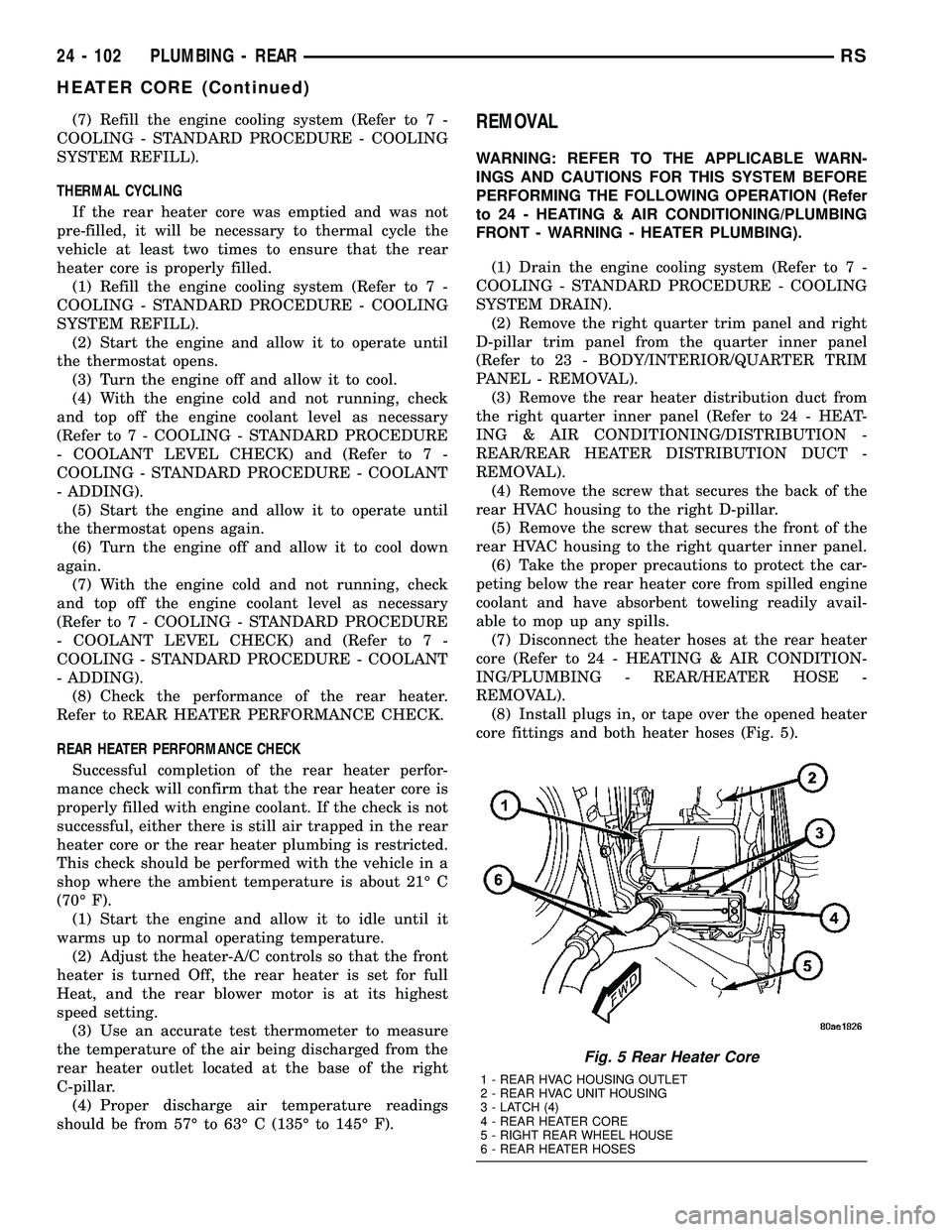
(7) Refill the engine cooling system (Refer to 7 -
COOLING - STANDARD PROCEDURE - COOLING
SYSTEM REFILL).
THERMAL CYCLING
If the rear heater core was emptied and was not
pre-filled, it will be necessary to thermal cycle the
vehicle at least two times to ensure that the rear
heater core is properly filled.
(1) Refill the engine cooling system (Refer to 7 -
COOLING - STANDARD PROCEDURE - COOLING
SYSTEM REFILL).
(2) Start the engine and allow it to operate until
the thermostat opens.
(3) Turn the engine off and allow it to cool.
(4) With the engine cold and not running, check
and top off the engine coolant level as necessary
(Refer to 7 - COOLING - STANDARD PROCEDURE
- COOLANT LEVEL CHECK) and (Refer to 7 -
COOLING - STANDARD PROCEDURE - COOLANT
- ADDING).
(5) Start the engine and allow it to operate until
the thermostat opens again.
(6) Turn the engine off and allow it to cool down
again.
(7) With the engine cold and not running, check
and top off the engine coolant level as necessary
(Refer to 7 - COOLING - STANDARD PROCEDURE
- COOLANT LEVEL CHECK) and (Refer to 7 -
COOLING - STANDARD PROCEDURE - COOLANT
- ADDING).
(8) Check the performance of the rear heater.
Refer to REAR HEATER PERFORMANCE CHECK.
REAR HEATER PERFORMANCE CHECK
Successful completion of the rear heater perfor-
mance check will confirm that the rear heater core is
properly filled with engine coolant. If the check is not
successful, either there is still air trapped in the rear
heater core or the rear heater plumbing is restricted.
This check should be performed with the vehicle in a
shop where the ambient temperature is about 21É C
(70É F).
(1) Start the engine and allow it to idle until it
warms up to normal operating temperature.
(2) Adjust the heater-A/C controls so that the front
heater is turned Off, the rear heater is set for full
Heat, and the rear blower motor is at its highest
speed setting.
(3) Use an accurate test thermometer to measure
the temperature of the air being discharged from the
rear heater outlet located at the base of the right
C-pillar.
(4) Proper discharge air temperature readings
should be from 57É to 63É C (135É to 145É F).REMOVAL
WARNING: REFER TO THE APPLICABLE WARN-
INGS AND CAUTIONS FOR THIS SYSTEM BEFORE
PERFORMING THE FOLLOWING OPERATION (Refer
to 24 - HEATING & AIR CONDITIONING/PLUMBING
FRONT - WARNING - HEATER PLUMBING).
(1) Drain the engine cooling system (Refer to 7 -
COOLING - STANDARD PROCEDURE - COOLING
SYSTEM DRAIN).
(2) Remove the right quarter trim panel and right
D-pillar trim panel from the quarter inner panel
(Refer to 23 - BODY/INTERIOR/QUARTER TRIM
PANEL - REMOVAL).
(3) Remove the rear heater distribution duct from
the right quarter inner panel (Refer to 24 - HEAT-
ING & AIR CONDITIONING/DISTRIBUTION -
REAR/REAR HEATER DISTRIBUTION DUCT -
REMOVAL).
(4) Remove the screw that secures the back of the
rear HVAC housing to the right D-pillar.
(5) Remove the screw that secures the front of the
rear HVAC housing to the right quarter inner panel.
(6) Take the proper precautions to protect the car-
peting below the rear heater core from spilled engine
coolant and have absorbent toweling readily avail-
able to mop up any spills.
(7) Disconnect the heater hoses at the rear heater
core (Refer to 24 - HEATING & AIR CONDITION-
ING/PLUMBING - REAR/HEATER HOSE -
REMOVAL).
(8) Install plugs in, or tape over the opened heater
core fittings and both heater hoses (Fig. 5).
Fig. 5 Rear Heater Core
1 - REAR HVAC HOUSING OUTLET
2 - REAR HVAC UNIT HOUSING
3 - LATCH (4)
4 - REAR HEATER CORE
5 - RIGHT REAR WHEEL HOUSE
6 - REAR HEATER HOSES
24 - 102 PLUMBING - REARRS
HEATER CORE (Continued)
Page 2498 of 2585
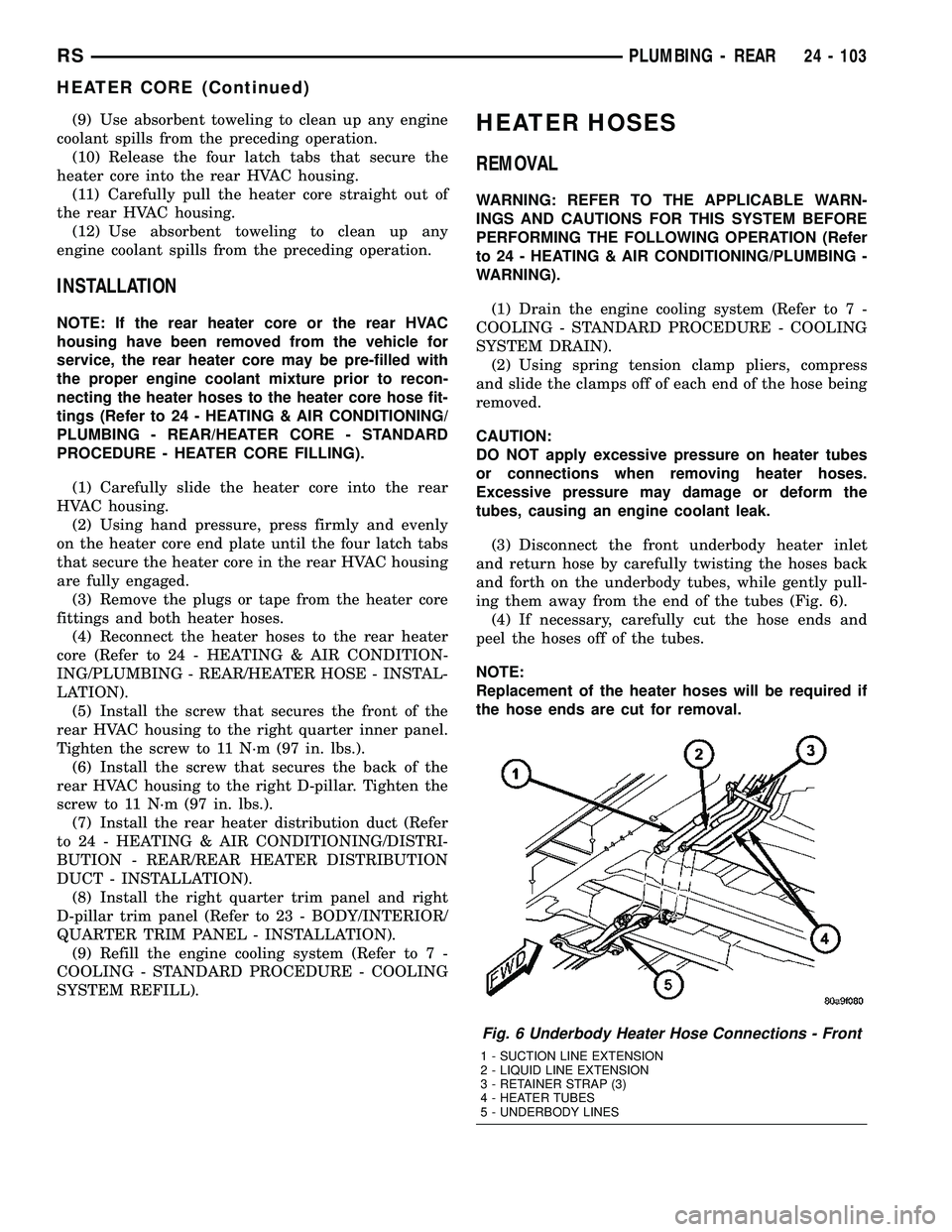
(9) Use absorbent toweling to clean up any engine
coolant spills from the preceding operation.
(10) Release the four latch tabs that secure the
heater core into the rear HVAC housing.
(11) Carefully pull the heater core straight out of
the rear HVAC housing.
(12) Use absorbent toweling to clean up any
engine coolant spills from the preceding operation.
INSTALLATION
NOTE: If the rear heater core or the rear HVAC
housing have been removed from the vehicle for
service, the rear heater core may be pre-filled with
the proper engine coolant mixture prior to recon-
necting the heater hoses to the heater core hose fit-
tings (Refer to 24 - HEATING & AIR CONDITIONING/
PLUMBING - REAR/HEATER CORE - STANDARD
PROCEDURE - HEATER CORE FILLING).
(1) Carefully slide the heater core into the rear
HVAC housing.
(2) Using hand pressure, press firmly and evenly
on the heater core end plate until the four latch tabs
that secure the heater core in the rear HVAC housing
are fully engaged.
(3) Remove the plugs or tape from the heater core
fittings and both heater hoses.
(4) Reconnect the heater hoses to the rear heater
core (Refer to 24 - HEATING & AIR CONDITION-
ING/PLUMBING - REAR/HEATER HOSE - INSTAL-
LATION).
(5) Install the screw that secures the front of the
rear HVAC housing to the right quarter inner panel.
Tighten the screw to 11 N´m (97 in. lbs.).
(6) Install the screw that secures the back of the
rear HVAC housing to the right D-pillar. Tighten the
screw to 11 N´m (97 in. lbs.).
(7) Install the rear heater distribution duct (Refer
to 24 - HEATING & AIR CONDITIONING/DISTRI-
BUTION - REAR/REAR HEATER DISTRIBUTION
DUCT - INSTALLATION).
(8) Install the right quarter trim panel and right
D-pillar trim panel (Refer to 23 - BODY/INTERIOR/
QUARTER TRIM PANEL - INSTALLATION).
(9) Refill the engine cooling system (Refer to 7 -
COOLING - STANDARD PROCEDURE - COOLING
SYSTEM REFILL).
HEATER HOSES
REMOVAL
WARNING: REFER TO THE APPLICABLE WARN-
INGS AND CAUTIONS FOR THIS SYSTEM BEFORE
PERFORMING THE FOLLOWING OPERATION (Refer
to 24 - HEATING & AIR CONDITIONING/PLUMBING -
WARNING).
(1) Drain the engine cooling system (Refer to 7 -
COOLING - STANDARD PROCEDURE - COOLING
SYSTEM DRAIN).
(2) Using spring tension clamp pliers, compress
and slide the clamps off of each end of the hose being
removed.
CAUTION:
DO NOT apply excessive pressure on heater tubes
or connections when removing heater hoses.
Excessive pressure may damage or deform the
tubes, causing an engine coolant leak.
(3) Disconnect the front underbody heater inlet
and return hose by carefully twisting the hoses back
and forth on the underbody tubes, while gently pull-
ing them away from the end of the tubes (Fig. 6).
(4) If necessary, carefully cut the hose ends and
peel the hoses off of the tubes.
NOTE:
Replacement of the heater hoses will be required if
the hose ends are cut for removal.
Fig. 6 Underbody Heater Hose Connections - Front
1 - SUCTION LINE EXTENSION
2 - LIQUID LINE EXTENSION
3 - RETAINER STRAP (3)
4 - HEATER TUBES
5 - UNDERBODY LINES
RSPLUMBING - REAR24 - 103
HEATER CORE (Continued)
Page 2499 of 2585
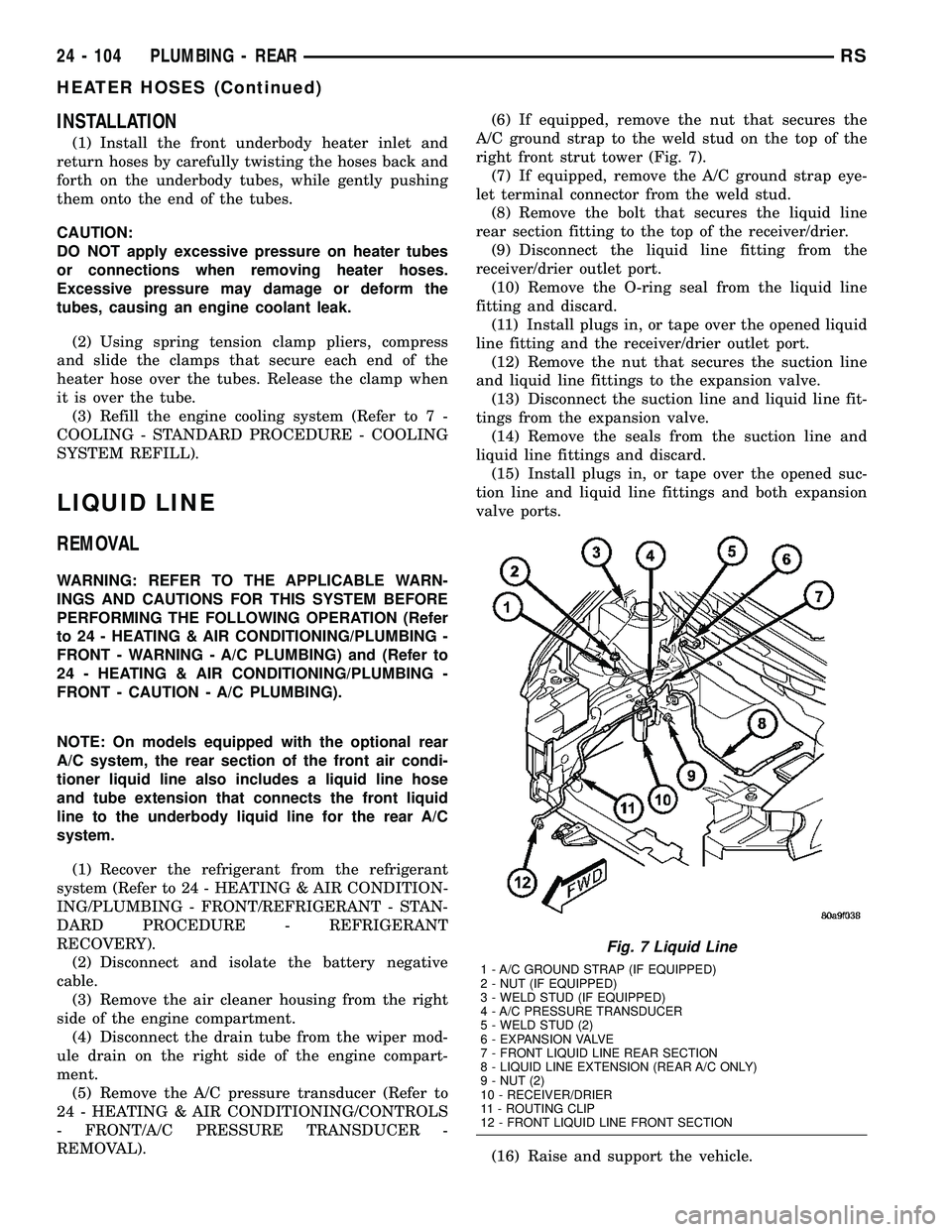
INSTALLATION
(1) Install the front underbody heater inlet and
return hoses by carefully twisting the hoses back and
forth on the underbody tubes, while gently pushing
them onto the end of the tubes.
CAUTION:
DO NOT apply excessive pressure on heater tubes
or connections when removing heater hoses.
Excessive pressure may damage or deform the
tubes, causing an engine coolant leak.
(2) Using spring tension clamp pliers, compress
and slide the clamps that secure each end of the
heater hose over the tubes. Release the clamp when
it is over the tube.
(3) Refill the engine cooling system (Refer to 7 -
COOLING - STANDARD PROCEDURE - COOLING
SYSTEM REFILL).
LIQUID LINE
REMOVAL
WARNING: REFER TO THE APPLICABLE WARN-
INGS AND CAUTIONS FOR THIS SYSTEM BEFORE
PERFORMING THE FOLLOWING OPERATION (Refer
to 24 - HEATING & AIR CONDITIONING/PLUMBING -
FRONT - WARNING - A/C PLUMBING) and (Refer to
24 - HEATING & AIR CONDITIONING/PLUMBING -
FRONT - CAUTION - A/C PLUMBING).
NOTE: On models equipped with the optional rear
A/C system, the rear section of the front air condi-
tioner liquid line also includes a liquid line hose
and tube extension that connects the front liquid
line to the underbody liquid line for the rear A/C
system.
(1) Recover the refrigerant from the refrigerant
system (Refer to 24 - HEATING & AIR CONDITION-
ING/PLUMBING - FRONT/REFRIGERANT - STAN-
DARD PROCEDURE - REFRIGERANT
RECOVERY).
(2) Disconnect and isolate the battery negative
cable.
(3) Remove the air cleaner housing from the right
side of the engine compartment.
(4) Disconnect the drain tube from the wiper mod-
ule drain on the right side of the engine compart-
ment.
(5) Remove the A/C pressure transducer (Refer to
24 - HEATING & AIR CONDITIONING/CONTROLS
- FRONT/A/C PRESSURE TRANSDUCER -
REMOVAL).(6) If equipped, remove the nut that secures the
A/C ground strap to the weld stud on the top of the
right front strut tower (Fig. 7).
(7) If equipped, remove the A/C ground strap eye-
let terminal connector from the weld stud.
(8) Remove the bolt that secures the liquid line
rear section fitting to the top of the receiver/drier.
(9) Disconnect the liquid line fitting from the
receiver/drier outlet port.
(10) Remove the O-ring seal from the liquid line
fitting and discard.
(11) Install plugs in, or tape over the opened liquid
line fitting and the receiver/drier outlet port.
(12) Remove the nut that secures the suction line
and liquid line fittings to the expansion valve.
(13) Disconnect the suction line and liquid line fit-
tings from the expansion valve.
(14) Remove the seals from the suction line and
liquid line fittings and discard.
(15) Install plugs in, or tape over the opened suc-
tion line and liquid line fittings and both expansion
valve ports.
(16) Raise and support the vehicle.
Fig. 7 Liquid Line
1 - A/C GROUND STRAP (IF EQUIPPED)
2 - NUT (IF EQUIPPED)
3 - WELD STUD (IF EQUIPPED)
4 - A/C PRESSURE TRANSDUCER
5 - WELD STUD (2)
6 - EXPANSION VALVE
7 - FRONT LIQUID LINE REAR SECTION
8 - LIQUID LINE EXTENSION (REAR A/C ONLY)
9 - NUT (2)
10 - RECEIVER/DRIER
11 - ROUTING CLIP
12 - FRONT LIQUID LINE FRONT SECTION
24 - 104 PLUMBING - REARRS
HEATER HOSES (Continued)
Page 2500 of 2585
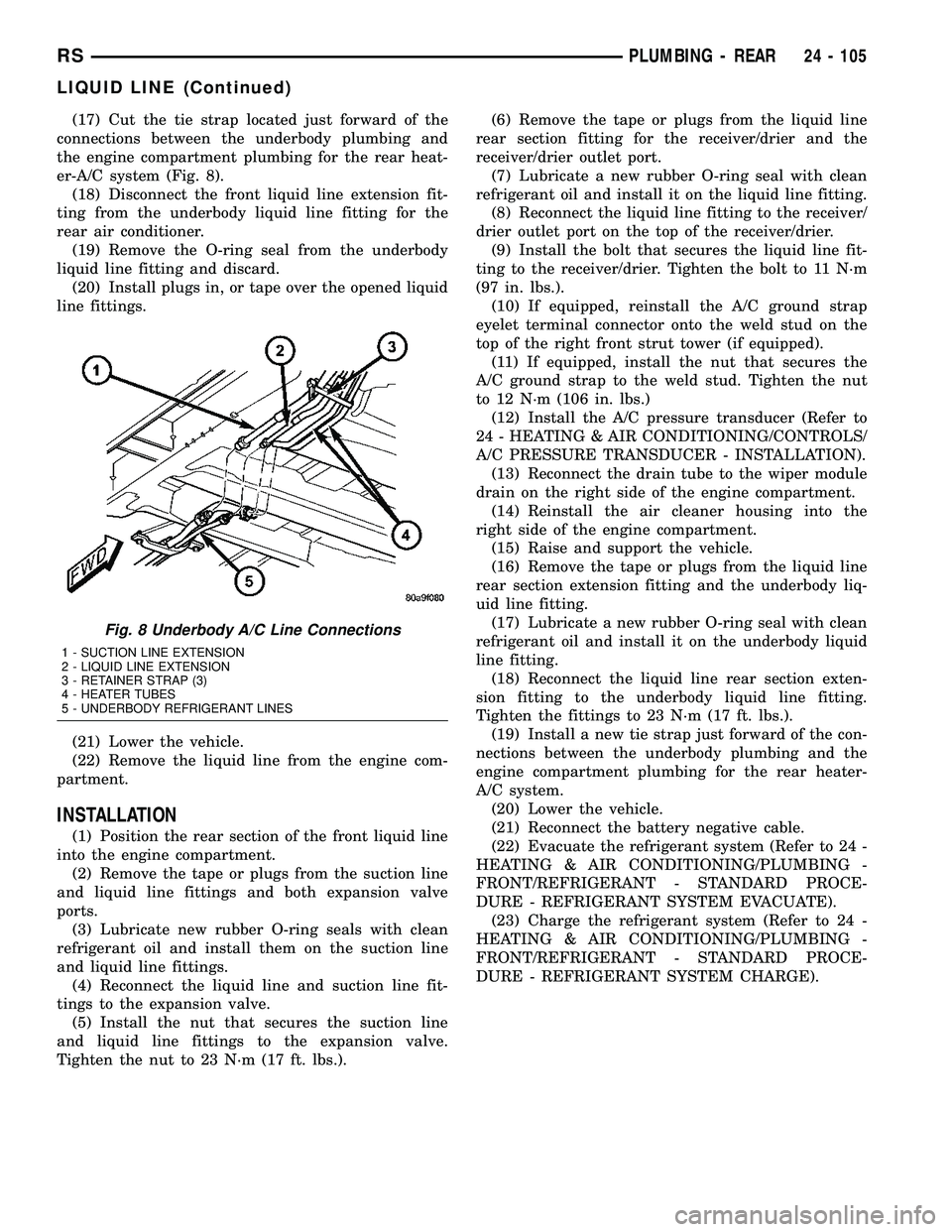
(17) Cut the tie strap located just forward of the
connections between the underbody plumbing and
the engine compartment plumbing for the rear heat-
er-A/C system (Fig. 8).
(18) Disconnect the front liquid line extension fit-
ting from the underbody liquid line fitting for the
rear air conditioner.
(19) Remove the O-ring seal from the underbody
liquid line fitting and discard.
(20) Install plugs in, or tape over the opened liquid
line fittings.
(21) Lower the vehicle.
(22) Remove the liquid line from the engine com-
partment.
INSTALLATION
(1) Position the rear section of the front liquid line
into the engine compartment.
(2) Remove the tape or plugs from the suction line
and liquid line fittings and both expansion valve
ports.
(3) Lubricate new rubber O-ring seals with clean
refrigerant oil and install them on the suction line
and liquid line fittings.
(4) Reconnect the liquid line and suction line fit-
tings to the expansion valve.
(5) Install the nut that secures the suction line
and liquid line fittings to the expansion valve.
Tighten the nut to 23 N´m (17 ft. lbs.).(6) Remove the tape or plugs from the liquid line
rear section fitting for the receiver/drier and the
receiver/drier outlet port.
(7) Lubricate a new rubber O-ring seal with clean
refrigerant oil and install it on the liquid line fitting.
(8) Reconnect the liquid line fitting to the receiver/
drier outlet port on the top of the receiver/drier.
(9) Install the bolt that secures the liquid line fit-
ting to the receiver/drier. Tighten the bolt to 11 N´m
(97 in. lbs.).
(10) If equipped, reinstall the A/C ground strap
eyelet terminal connector onto the weld stud on the
top of the right front strut tower (if equipped).
(11) If equipped, install the nut that secures the
A/C ground strap to the weld stud. Tighten the nut
to 12 N´m (106 in. lbs.)
(12) Install the A/C pressure transducer (Refer to
24 - HEATING & AIR CONDITIONING/CONTROLS/
A/C PRESSURE TRANSDUCER - INSTALLATION).
(13) Reconnect the drain tube to the wiper module
drain on the right side of the engine compartment.
(14) Reinstall the air cleaner housing into the
right side of the engine compartment.
(15) Raise and support the vehicle.
(16) Remove the tape or plugs from the liquid line
rear section extension fitting and the underbody liq-
uid line fitting.
(17) Lubricate a new rubber O-ring seal with clean
refrigerant oil and install it on the underbody liquid
line fitting.
(18) Reconnect the liquid line rear section exten-
sion fitting to the underbody liquid line fitting.
Tighten the fittings to 23 N´m (17 ft. lbs.).
(19) Install a new tie strap just forward of the con-
nections between the underbody plumbing and the
engine compartment plumbing for the rear heater-
A/C system.
(20) Lower the vehicle.
(21) Reconnect the battery negative cable.
(22) Evacuate the refrigerant system (Refer to 24 -
HEATING & AIR CONDITIONING/PLUMBING -
FRONT/REFRIGERANT - STANDARD PROCE-
DURE - REFRIGERANT SYSTEM EVACUATE).
(23) Charge the refrigerant system (Refer to 24 -
HEATING & AIR CONDITIONING/PLUMBING -
FRONT/REFRIGERANT - STANDARD PROCE-
DURE - REFRIGERANT SYSTEM CHARGE).
Fig. 8 Underbody A/C Line Connections
1 - SUCTION LINE EXTENSION
2 - LIQUID LINE EXTENSION
3 - RETAINER STRAP (3)
4 - HEATER TUBES
5 - UNDERBODY REFRIGERANT LINES
RSPLUMBING - REAR24 - 105
LIQUID LINE (Continued)
Page 2501 of 2585
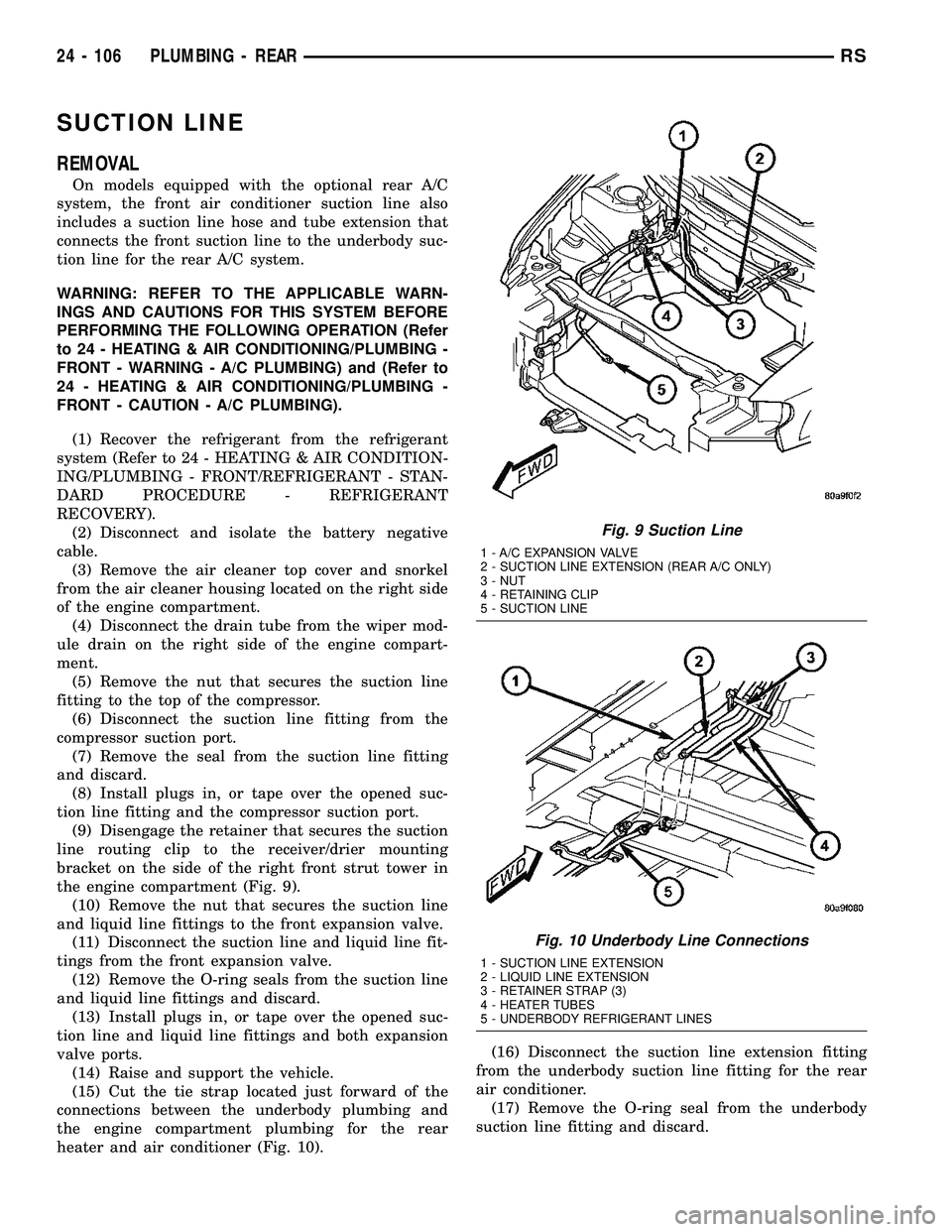
SUCTION LINE
REMOVAL
On models equipped with the optional rear A/C
system, the front air conditioner suction line also
includes a suction line hose and tube extension that
connects the front suction line to the underbody suc-
tion line for the rear A/C system.
WARNING: REFER TO THE APPLICABLE WARN-
INGS AND CAUTIONS FOR THIS SYSTEM BEFORE
PERFORMING THE FOLLOWING OPERATION (Refer
to 24 - HEATING & AIR CONDITIONING/PLUMBING -
FRONT - WARNING - A/C PLUMBING) and (Refer to
24 - HEATING & AIR CONDITIONING/PLUMBING -
FRONT - CAUTION - A/C PLUMBING).
(1) Recover the refrigerant from the refrigerant
system (Refer to 24 - HEATING & AIR CONDITION-
ING/PLUMBING - FRONT/REFRIGERANT - STAN-
DARD PROCEDURE - REFRIGERANT
RECOVERY).
(2) Disconnect and isolate the battery negative
cable.
(3) Remove the air cleaner top cover and snorkel
from the air cleaner housing located on the right side
of the engine compartment.
(4) Disconnect the drain tube from the wiper mod-
ule drain on the right side of the engine compart-
ment.
(5) Remove the nut that secures the suction line
fitting to the top of the compressor.
(6) Disconnect the suction line fitting from the
compressor suction port.
(7) Remove the seal from the suction line fitting
and discard.
(8) Install plugs in, or tape over the opened suc-
tion line fitting and the compressor suction port.
(9) Disengage the retainer that secures the suction
line routing clip to the receiver/drier mounting
bracket on the side of the right front strut tower in
the engine compartment (Fig. 9).
(10) Remove the nut that secures the suction line
and liquid line fittings to the front expansion valve.
(11) Disconnect the suction line and liquid line fit-
tings from the front expansion valve.
(12) Remove the O-ring seals from the suction line
and liquid line fittings and discard.
(13) Install plugs in, or tape over the opened suc-
tion line and liquid line fittings and both expansion
valve ports.
(14) Raise and support the vehicle.
(15) Cut the tie strap located just forward of the
connections between the underbody plumbing and
the engine compartment plumbing for the rear
heater and air conditioner (Fig. 10).(16) Disconnect the suction line extension fitting
from the underbody suction line fitting for the rear
air conditioner.
(17) Remove the O-ring seal from the underbody
suction line fitting and discard.
Fig. 9 Suction Line
1 - A/C EXPANSION VALVE
2 - SUCTION LINE EXTENSION (REAR A/C ONLY)
3 - NUT
4 - RETAINING CLIP
5 - SUCTION LINE
Fig. 10 Underbody Line Connections
1 - SUCTION LINE EXTENSION
2 - LIQUID LINE EXTENSION
3 - RETAINER STRAP (3)
4 - HEATER TUBES
5 - UNDERBODY REFRIGERANT LINES
24 - 106 PLUMBING - REARRS
Page 2502 of 2585
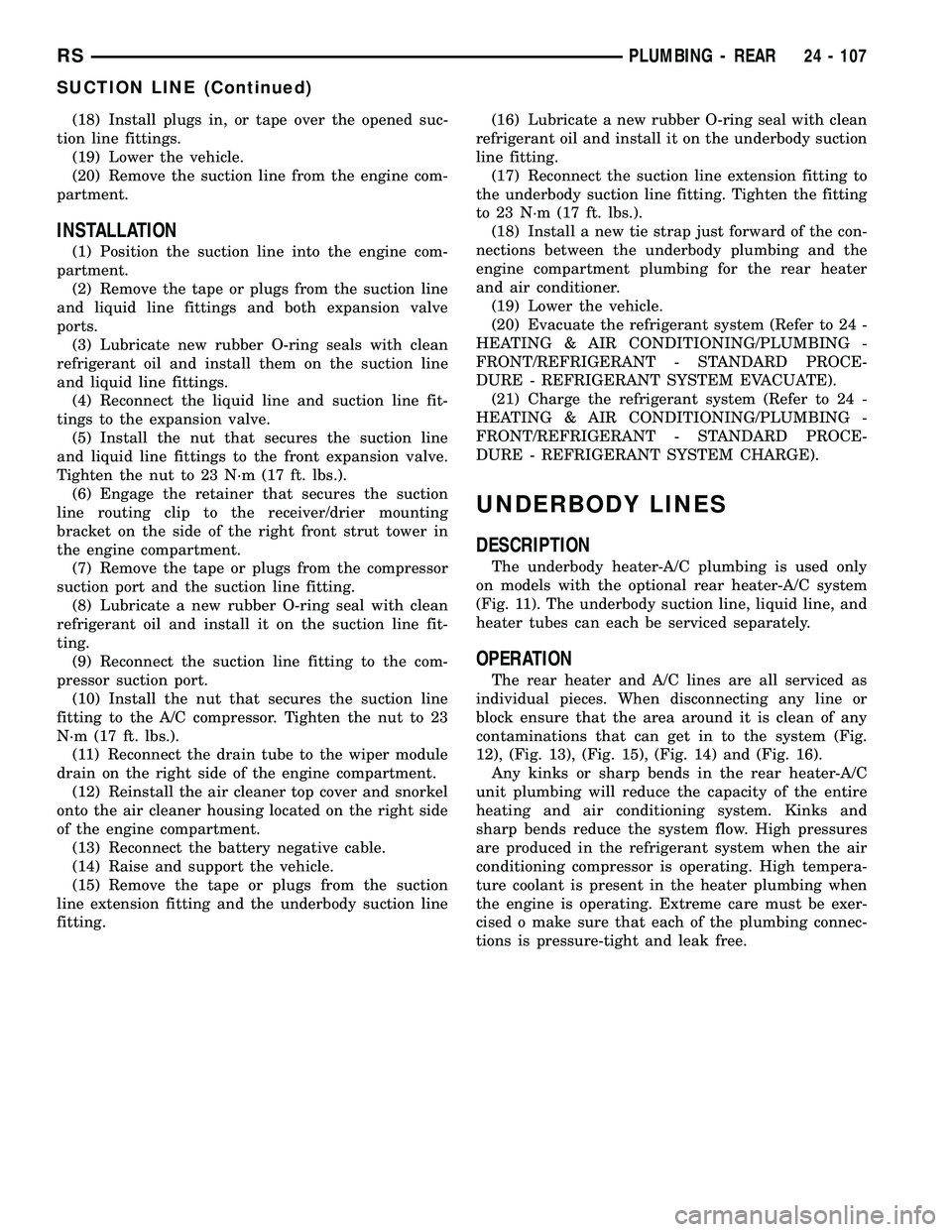
(18) Install plugs in, or tape over the opened suc-
tion line fittings.
(19) Lower the vehicle.
(20) Remove the suction line from the engine com-
partment.
INSTALLATION
(1) Position the suction line into the engine com-
partment.
(2) Remove the tape or plugs from the suction line
and liquid line fittings and both expansion valve
ports.
(3) Lubricate new rubber O-ring seals with clean
refrigerant oil and install them on the suction line
and liquid line fittings.
(4) Reconnect the liquid line and suction line fit-
tings to the expansion valve.
(5) Install the nut that secures the suction line
and liquid line fittings to the front expansion valve.
Tighten the nut to 23 N´m (17 ft. lbs.).
(6) Engage the retainer that secures the suction
line routing clip to the receiver/drier mounting
bracket on the side of the right front strut tower in
the engine compartment.
(7) Remove the tape or plugs from the compressor
suction port and the suction line fitting.
(8) Lubricate a new rubber O-ring seal with clean
refrigerant oil and install it on the suction line fit-
ting.
(9) Reconnect the suction line fitting to the com-
pressor suction port.
(10) Install the nut that secures the suction line
fitting to the A/C compressor. Tighten the nut to 23
N´m (17 ft. lbs.).
(11) Reconnect the drain tube to the wiper module
drain on the right side of the engine compartment.
(12) Reinstall the air cleaner top cover and snorkel
onto the air cleaner housing located on the right side
of the engine compartment.
(13) Reconnect the battery negative cable.
(14) Raise and support the vehicle.
(15) Remove the tape or plugs from the suction
line extension fitting and the underbody suction line
fitting.(16) Lubricate a new rubber O-ring seal with clean
refrigerant oil and install it on the underbody suction
line fitting.
(17) Reconnect the suction line extension fitting to
the underbody suction line fitting. Tighten the fitting
to 23 N´m (17 ft. lbs.).
(18) Install a new tie strap just forward of the con-
nections between the underbody plumbing and the
engine compartment plumbing for the rear heater
and air conditioner.
(19) Lower the vehicle.
(20) Evacuate the refrigerant system (Refer to 24 -
HEATING & AIR CONDITIONING/PLUMBING -
FRONT/REFRIGERANT - STANDARD PROCE-
DURE - REFRIGERANT SYSTEM EVACUATE).
(21) Charge the refrigerant system (Refer to 24 -
HEATING & AIR CONDITIONING/PLUMBING -
FRONT/REFRIGERANT - STANDARD PROCE-
DURE - REFRIGERANT SYSTEM CHARGE).
UNDERBODY LINES
DESCRIPTION
The underbody heater-A/C plumbing is used only
on models with the optional rear heater-A/C system
(Fig. 11). The underbody suction line, liquid line, and
heater tubes can each be serviced separately.
OPERATION
The rear heater and A/C lines are all serviced as
individual pieces. When disconnecting any line or
block ensure that the area around it is clean of any
contaminations that can get in to the system (Fig.
12), (Fig. 13), (Fig. 15), (Fig. 14) and (Fig. 16).
Any kinks or sharp bends in the rear heater-A/C
unit plumbing will reduce the capacity of the entire
heating and air conditioning system. Kinks and
sharp bends reduce the system flow. High pressures
are produced in the refrigerant system when the air
conditioning compressor is operating. High tempera-
ture coolant is present in the heater plumbing when
the engine is operating. Extreme care must be exer-
cised o make sure that each of the plumbing connec-
tions is pressure-tight and leak free.
RSPLUMBING - REAR24 - 107
SUCTION LINE (Continued)
Page 2511 of 2585
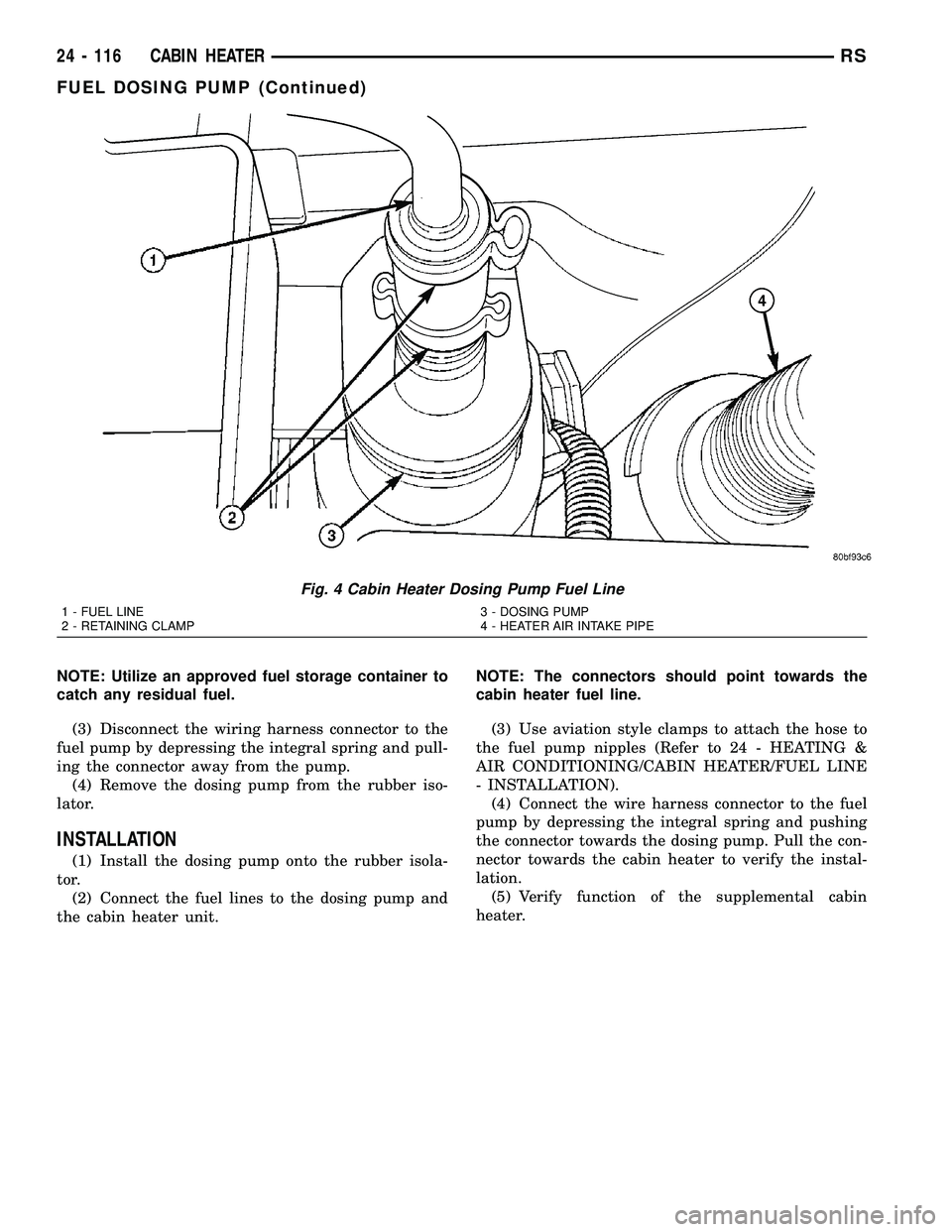
NOTE: Utilize an approved fuel storage container to
catch any residual fuel.
(3) Disconnect the wiring harness connector to the
fuel pump by depressing the integral spring and pull-
ing the connector away from the pump.
(4) Remove the dosing pump from the rubber iso-
lator.
INSTALLATION
(1) Install the dosing pump onto the rubber isola-
tor.
(2) Connect the fuel lines to the dosing pump and
the cabin heater unit.NOTE: The connectors should point towards the
cabin heater fuel line.
(3) Use aviation style clamps to attach the hose to
the fuel pump nipples (Refer to 24 - HEATING &
AIR CONDITIONING/CABIN HEATER/FUEL LINE
- INSTALLATION).
(4) Connect the wire harness connector to the fuel
pump by depressing the integral spring and pushing
the connector towards the dosing pump. Pull the con-
nector towards the cabin heater to verify the instal-
lation.
(5) Verify function of the supplemental cabin
heater.
Fig. 4 Cabin Heater Dosing Pump Fuel Line
1 - FUEL LINE
2 - RETAINING CLAMP3 - DOSING PUMP
4 - HEATER AIR INTAKE PIPE
24 - 116 CABIN HEATERRS
FUEL DOSING PUMP (Continued)
Page 2579 of 2585
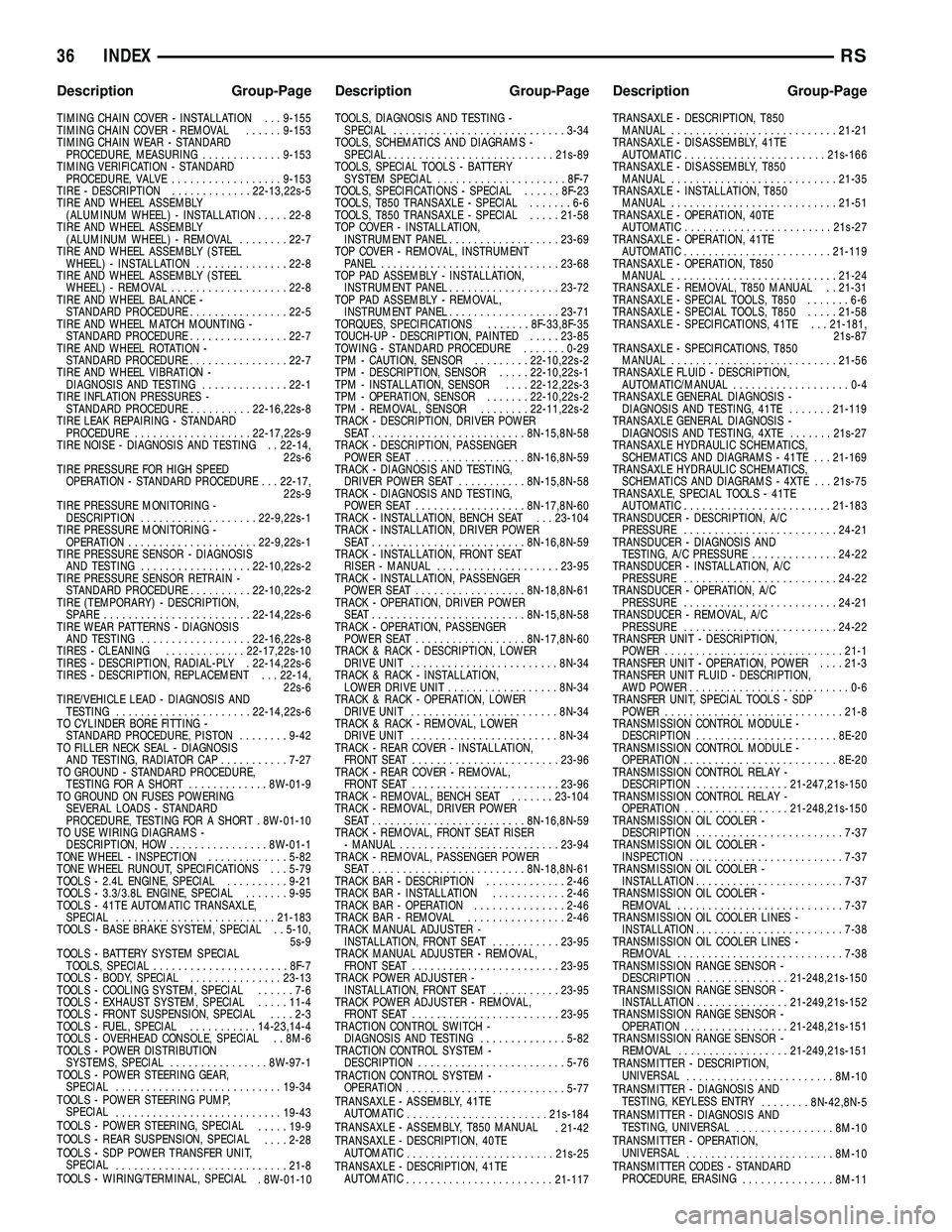
TIMING CHAIN COVER - INSTALLATION . . . 9-155
TIMING CHAIN COVER - REMOVAL......9-153
TIMING CHAIN WEAR - STANDARD
PROCEDURE, MEASURING.............9-153
TIMING VERIFICATION - STANDARD
PROCEDURE, VALVE..................9-153
TIRE - DESCRIPTION.............22-13,22s-5
TIRE AND WHEEL ASSEMBLY
(ALUMINUM WHEEL) - INSTALLATION.....22-8
TIRE AND WHEEL ASSEMBLY
(ALUMINUM WHEEL) - REMOVAL........22-7
TIRE AND WHEEL ASSEMBLY (STEEL
WHEEL) - INSTALLATION...............22-8
TIRE AND WHEEL ASSEMBLY (STEEL
WHEEL) - REMOVAL...................22-8
TIRE AND WHEEL BALANCE -
STANDARD PROCEDURE................22-5
TIRE AND WHEEL MATCH MOUNTING -
STANDARD PROCEDURE................22-7
TIRE AND WHEEL ROTATION -
STANDARD PROCEDURE................22-7
TIRE AND WHEEL VIBRATION -
DIAGNOSIS AND TESTING..............22-1
TIRE INFLATION PRESSURES -
STANDARD PROCEDURE..........22-16,22s-8
TIRE LEAK REPAIRING - STANDARD
PROCEDURE...................22-17,22s-9
TIRE NOISE - DIAGNOSIS AND TESTING . . 22-14,
22s-6
TIRE PRESSURE FOR HIGH SPEED
OPERATION - STANDARD PROCEDURE . . . 22-17,
22s-9
TIRE PRESSURE MONITORING -
DESCRIPTION...................22-9,22s-1
TIRE PRESSURE MONITORING -
OPERATION.....................22-9,22s-1
TIRE PRESSURE SENSOR - DIAGNOSIS
AND TESTING..................22-10,22s-2
TIRE PRESSURE SENSOR RETRAIN -
STANDARD PROCEDURE..........22-10,22s-2
TIRE (TEMPORARY) - DESCRIPTION,
SPARE ........................22-14,22s-6
TIRE WEAR PATTERNS - DIAGNOSIS
AND TESTING..................22-16,22s-8
TIRES - CLEANING.............22-17,22s-10
TIRES - DESCRIPTION, RADIAL-PLY . 22-14,22s-6
TIRES - DESCRIPTION, REPLACEMENT . . . 22-14,
22s-6
TIRE/VEHICLE LEAD - DIAGNOSIS AND
TESTING......................22-14,22s-6
TO CYLINDER BORE FITTING -
STANDARD PROCEDURE, PISTON........9-42
TO FILLER NECK SEAL - DIAGNOSIS
AND TESTING, RADIATOR CAP...........7-27
TO GROUND - STANDARD PROCEDURE,
TESTING FOR A SHORT.............8W-01-9
TO GROUND ON FUSES POWERING
SEVERAL LOADS - STANDARD
PROCEDURE, TESTING FOR A SHORT . 8W-01-10
TO USE WIRING DIAGRAMS -
DESCRIPTION, HOW................8W-01-1
TONE WHEEL - INSPECTION.............5-82
TONE WHEEL RUNOUT, SPECIFICATIONS . . . 5-79
TOOLS - 2.4L ENGINE, SPECIAL..........9-21
TOOLS - 3.3/3.8L ENGINE, SPECIAL.......9-95
TOOLS - 41TE AUTOMATIC TRANSAXLE,
SPECIAL..........................21-183
TOOLS - BASE BRAKE SYSTEM, SPECIAL . . 5-10,
5s-9
TOOLS - BATTERY SYSTEM SPECIAL
TOOLS, SPECIAL......................8F-7
TOOLS - BODY, SPECIAL...............23-13
TOOLS - COOLING SYSTEM, SPECIAL......7-6
TOOLS - EXHAUST SYSTEM, SPECIAL.....11-4
TOOLS - FRONT SUSPENSION, SPECIAL....2-3
TOOLS - FUEL, SPECIAL...........14-23,14-4
TOOLS - OVERHEAD CONSOLE, SPECIAL . . 8M-6
TOOLS - POWER DISTRIBUTION
SYSTEMS, SPECIAL................8W-97-1
TOOLS - POWER STEERING GEAR,
SPECIAL...........................19-34
TOOLS - POWER STEERING PUMP,
SPECIAL
...........................19-43
TOOLS - POWER STEERING, SPECIAL
.....19-9
TOOLS - REAR SUSPENSION, SPECIAL
....2-28
TOOLS - SDP POWER TRANSFER UNIT,
SPECIAL
............................21-8
TOOLS - WIRING/TERMINAL, SPECIAL
. 8W-01-10TOOLS, DIAGNOSIS AND TESTING -
SPECIAL............................3-34
TOOLS, SCHEMATICS AND DIAGRAMS -
SPECIAL...........................21s-89
TOOLS, SPECIAL TOOLS - BATTERY
SYSTEM SPECIAL.....................8F-7
TOOLS, SPECIFICATIONS - SPECIAL......8F-23
TOOLS, T850 TRANSAXLE - SPECIAL.......6-6
TOOLS, T850 TRANSAXLE - SPECIAL.....21-58
TOP COVER - INSTALLATION,
INSTRUMENT PANEL..................23-69
TOP COVER - REMOVAL, INSTRUMENT
PANEL.............................23-68
TOP PAD ASSEMBLY - INSTALLATION,
INSTRUMENT PANEL..................23-72
TOP PAD ASSEMBLY - REMOVAL,
INSTRUMENT PANEL..................23-71
TORQUES, SPECIFICATIONS.......8F-33,8F-35
TOUCH-UP - DESCRIPTION, PAINTED.....23-85
TOWING - STANDARD PROCEDURE.......0-29
TPM - CAUTION, SENSOR.........22-10,22s-2
TPM - DESCRIPTION, SENSOR.....22-10,22s-1
TPM - INSTALLATION, SENSOR....22-12,22s-3
TPM - OPERATION, SENSOR.......22-10,22s-2
TPM - REMOVAL, SENSOR........22-11,22s-2
TRACK - DESCRIPTION, DRIVER POWER
SEAT.........................8N-15,8N-58
TRACK - DESCRIPTION, PASSENGER
POWER SEAT..................8N-16,8N-59
TRACK - DIAGNOSIS AND TESTING,
DRIVER POWER SEAT...........8N-15,8N-58
TRACK - DIAGNOSIS AND TESTING,
POWER SEAT..................8N-17,8N-60
TRACK - INSTALLATION, BENCH SEAT . . . 23-104
TRACK - INSTALLATION, DRIVER POWER
SEAT.........................8N-16,8N-59
TRACK - INSTALLATION, FRONT SEAT
RISER - MANUAL....................23-95
TRACK - INSTALLATION, PASSENGER
POWER SEAT..................8N-18,8N-61
TRACK - OPERATION, DRIVER POWER
SEAT.........................8N-15,8N-58
TRACK - OPERATION, PASSENGER
POWER SEAT..................8N-17,8N-60
TRACK & RACK - DESCRIPTION, LOWER
DRIVE UNIT........................8N-34
TRACK & RACK - INSTALLATION,
LOWER DRIVE UNIT..................8N-34
TRACK & RACK - OPERATION, LOWER
DRIVE UNIT........................8N-34
TRACK & RACK - REMOVAL, LOWER
DRIVE UNIT........................8N-34
TRACK - REAR COVER - INSTALLATION,
FRONT SEAT........................23-96
TRACK - REAR COVER - REMOVAL,
FRONT SEAT........................23-96
TRACK - REMOVAL, BENCH SEAT.......23-104
TRACK - REMOVAL, DRIVER POWER
SEAT.........................8N-16,8N-59
TRACK - REMOVAL, FRONT SEAT RISER
- MANUAL..........................23-94
TRACK - REMOVAL, PASSENGER POWER
SEAT.........................8N-18,8N-61
TRACK BAR - DESCRIPTION.............2-46
TRACK BAR - INSTALLATION............2-46
TRACK BAR - OPERATION...............2-46
TRACK BAR - REMOVAL................2-46
TRACK MANUAL ADJUSTER -
INSTALLATION, FRONT SEAT...........23-95
TRACK MANUAL ADJUSTER - REMOVAL,
FRONT SEAT........................23-95
TRACK POWER ADJUSTER -
INSTALLATION, FRONT SEAT...........23-95
TRACK POWER ADJUSTER - REMOVAL,
FRONT SEAT........................23-95
TRACTION CONTROL SWITCH -
DIAGNOSIS AND TESTING..............5-82
TRACTION CONTROL SYSTEM -
DESCRIPTION........................5-76
TRACTION CONTROL SYSTEM -
OPERATION
..........................5-77
TRANSAXLE - ASSEMBLY, 41TE
AUTOMATIC
.......................21s-184
TRANSAXLE - ASSEMBLY, T850 MANUAL
. 21-42
TRANSAXLE - DESCRIPTION, 40TE
AUTOMATIC
........................21s-25
TRANSAXLE - DESCRIPTION, 41TE
AUTOMATIC
........................21-117TRANSAXLE - DESCRIPTION, T850
MANUAL...........................21-21
TRANSAXLE - DISASSEMBLY, 41TE
AUTOMATIC.......................21s-166
TRANSAXLE - DISASSEMBLY, T850
MANUAL...........................21-35
TRANSAXLE - INSTALLATION, T850
MANUAL...........................21-51
TRANSAXLE - OPERATION, 40TE
AUTOMATIC........................21s-27
TRANSAXLE - OPERATION, 41TE
AUTOMATIC........................21-119
TRANSAXLE - OPERATION, T850
MANUAL...........................21-24
TRANSAXLE - REMOVAL, T850 MANUAL . . 21-31
TRANSAXLE - SPECIAL TOOLS, T850.......6-6
TRANSAXLE - SPECIAL TOOLS, T850.....21-58
TRANSAXLE - SPECIFICATIONS, 41TE . . . 21-181,
21s-87
TRANSAXLE - SPECIFICATIONS, T850
MANUAL...........................21-56
TRANSAXLE FLUID - DESCRIPTION,
AUTOMATIC/MANUAL...................0-4
TRANSAXLE GENERAL DIAGNOSIS -
DIAGNOSIS AND TESTING, 41TE.......21-119
TRANSAXLE GENERAL DIAGNOSIS -
DIAGNOSIS AND TESTING, 4XTE.......21s-27
TRANSAXLE HYDRAULIC SCHEMATICS,
SCHEMATICS AND DIAGRAMS - 41TE . . . 21-169
TRANSAXLE HYDRAULIC SCHEMATICS,
SCHEMATICS AND DIAGRAMS - 4XTE . . . 21s-75
TRANSAXLE, SPECIAL TOOLS - 41TE
AUTOMATIC.........................21-183
TRANSDUCER - DESCRIPTION, A/C
PRESSURE.........................24-21
TRANSDUCER - DIAGNOSIS AND
TESTING, A/C PRESSURE..............24-22
TRANSDUCER - INSTALLATION, A/C
PRESSURE.........................24-22
TRANSDUCER - OPERATION, A/C
PRESSURE.........................24-21
TRANSDUCER - REMOVAL, A/C
PRESSURE.........................24-22
TRANSFER UNIT - DESCRIPTION,
POWER.............................21-1
TRANSFER UNIT - OPERATION, POWER....21-3
TRANSFER UNIT FLUID - DESCRIPTION,
AWD POWER..........................0-6
TRANSFER UNIT, SPECIAL TOOLS - SDP
POWER.............................21-8
TRANSMISSION CONTROL MODULE -
DESCRIPTION.......................8E-20
TRANSMISSION CONTROL MODULE -
OPERATION.........................8E-20
TRANSMISSION CONTROL RELAY -
DESCRIPTION...............21-247,21s-150
TRANSMISSION CONTROL RELAY -
OPERATION.................21-248,21s-150
TRANSMISSION OIL COOLER -
DESCRIPTION........................7-37
TRANSMISSION OIL COOLER -
INSPECTION.........................7-37
TRANSMISSION OIL COOLER -
INSTALLATION........................7-37
TRANSMISSION OIL COOLER -
REMOVAL...........................7-37
TRANSMISSION OIL COOLER LINES -
INSTALLATION........................7-38
TRANSMISSION OIL COOLER LINES -
REMOVAL...........................7-38
TRANSMISSION RANGE SENSOR -
DESCRIPTION...............21-248,21s-150
TRANSMISSION RANGE SENSOR -
INSTALLATION...............21-249,21s-152
TRANSMISSION RANGE SENSOR -
OPERATION.................21-248,21s-151
TRANSMISSION RANGE SENSOR -
REMOVAL..................21-249,21s-151
TRANSMITTER - DESCRIPTION,
UNIVERSAL
........................8M-10
TRANSMITTER - DIAGNOSIS AND
TESTING, KEYLESS ENTRY
........8N-42,8N-5
TRANSMITTER - DIAGNOSIS AND
TESTING, UNIVERSAL
................8M-10
TRANSMITTER - OPERATION,
UNIVERSAL
........................8M-10
TRANSMITTER CODES - STANDARD
PROCEDURE, ERASING
...............8M-11
36 INDEXRS
Description Group-Page Description Group-Page Description Group-Page